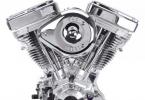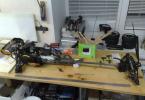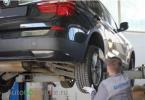- Introduction
1.1. This Instruction regulates the basic safety requirements when towing, coupling and caring cars or car and trailer (semi-trailer).
1.2.Reider or a specially appointed person when performing work on towing, coupling and crawling cars or a car and trailer (semi-sext) should:
comply with the requirements of the labor protection instructions developed on the basis of this Typical instruction;
know and be able to provide a prefigure assistance to the victim in accordance with the model instruction No. 22 to render prefigure assistance in accidents;
to comply with the instructions of the representative of the Joint Committee (Commission) on labor protection or an authorized (trusted) person on labor protection of the trade union committee.
Noticing a violation of security requirements by another employee, to prevent him about the need to comply with them.
- General security requirements.
2.1. Towing, coupling and crawling cars or car and trailer drivers or specially designated persons who have received introductory instructions and primary instructions in the workplace on labor protection and trained in safe work methods are allowed.
2.2. The aspectant that has not passed in a timely manner of labor protection (no less than 1 time in 3 months), should not start work.
2.3. When towing, coupling and extinguishment, it is necessary to be attentive, not distracted by foreign affairs and conversations.
2.4. When tugging, coupling and extinguishing, you need to know and remember that accidents can most often occur when:
work with an unreliable inhibited car, trailer, semi-trailer;
finding an employee between a towing car with a working engine and a trailer or towed car during a hitch or disabled;
use of random items as a tug;
inconsistent actions of drivers towing and towed cars.
2.5. For failure to comply with the requirements of the instruction developed on the basis of this typical instruction, an employee, producing towing, coupling, a car or car and trailer (semi-trailer), is responsible in accordance with the current legislation.
- Security requirements before starting work.
3.1. Before the start of work, an employee, producing towing, coupling, a car crawling or a car and trailer (semi-trailer), should:
check the health of trailers (semi-trailers), their towing devices, the presence and health of fixtures and tools;
remove unauthorized persons from the work area.
- Safety requirements during operation.
4.1. Read more coupling and crawling car and trailer (semi-trailer) The latter must be braked parking brake, Lay on wheels anti-collective stops (shoes).
4.2.The time of supplying a car - a tractor to the trailed vehicle is prohibited from finding people between this vehicle and a moving car.
4.3. The link or extinguction should be made on a flat horizontal surface, and the longitudinal axis of the semi-trailer semi-trailer must coincide with the longitudinal axis of the car - the tractor.
4.4. The list of the road train, consisting of a car and two or more trailers, should produce three people - the driver, a person who produces a coupling, and a person coordinating their work.
In exceptional cases (long-distance flights, exporting agricultural products from fields and so on), the hitch is allowed to produce one driver.
4.5. The driver of the trailer coupling (semi-trailer) driver must make sure that:
connecting hoses and electric pipes do not interfere with the coupling;
board closed;
sadelno - hitch, kkvorn and their attachments are good;
the front part of the semi-trailer in height is located in such a way that the front edge of the support sheet falls on the sled or on the saddle.
4.6. Print the hitch or extinguision drawing a trailer that does not have retaining springs should be installed on a rack protecting it from falling.
4.7. Start the trailer or semi-trailer and remove the stops from under the wheels only after the end of the hitch.
4.8.The you set up between the car and the trailer, the car driver should slow down the car in the parking brake, drown out the engine and put the gear shift lever (controller) to the neutral position.
4.10. Considation of a car on a tight or flexible coupling It should be carried out in the presence of a driver behind the wheel of the towed vehicle, except when the rigid coupling design provides with a straightforward movement following the towing vehicle along the trajectory of the towing.
4.11. Drinking on a flexible coupling should be provided between towing and towed vehicles within 4 - 6 m, and when towing on a rigid hitch - no more than 4 m.
4.12. Accounting is prohibited:
vehiclewho do not work steering (Towing method is allowed partial loading);
two or more vehicles;
vehicles with invalid brake systemif their actual mass of more than half of the actual mass of the towing vehicle.
at a smaller actual mass, the towing of such vehicles is allowed only on a rigid coupling or partial loading method;
in Hollyeditsa on a flexible coupling.
4.13. Drinking on a flexible or rigid clutch forbidden to find people in a towed bus, in the body of towed truck.
When towing by partial loading, it is forbidden to find people in the cabin or the body of a towed car, as well as in the body of a towing car.
4.14. Drinking on a flexible coupling It is forbidden to pull the cable with jerks. It is forbidden to find people closer than 6 m from the tensioned cable.
4.15. Current metal cables should have at the ends of the loop with a special sealing.
- Safety requirements in emergency situations.
5.10. Each accident, an eyewitness of which he was, an employee must immediately inform the administration of the enterprise, and the victim to provide the first prefigure help, call a doctor, to help deliver the victim to the health facility or the nearest medical institution.
If the accident occurred with the employee himself, he should, if possible, contact the health center, inform about the incident of the enterprise administration or ask to make it anyone from others.
- Security requirements at the end of work.
6.1. When the end of work.
Not all drivers are familiar with the rules of towing vehicles: in the driving schools this section is given enough time, and in practice, not many have experienced themselves as a driver towing or towed vehicles.
In real road situation Lack of theoretical I. practical knowledge Causes certain difficulties.
In this article, consider the main points of the car towing.
Towing is prohibited / permitted
Let's start with the fact that the PPD is prohibited to tow the vehicle:

Penalty for violation of the rules of towing a car in 2019 will be 500 rubles. This, of course, is a bit, but the collision of the "slave" and the "leading" vehicles of positive emotions does not cause.
And what about helping the car enthusiast in trouble?
In addition to the transport itself, the corresponding state of the flexible coupling is also. It should be a whole, not having damage and scuff, loops and carbines for fastening should be good.
 The length of the cable is at least 4 and no more than 5 meters.If he is shorter, then the chance of the second car to enter the front seeks to one hundred percent, and if longer than the car traveling to the back will strongly deviate from the trajectory of movement.
The length of the cable is at least 4 and no more than 5 meters.If he is shorter, then the chance of the second car to enter the front seeks to one hundred percent, and if longer than the car traveling to the back will strongly deviate from the trajectory of movement.
Fal must have warning shields or flags. These are devices with diagonally drawn reflective white and red stripes. If there are no - you can use pieces of red fabric.
Modern steel cables It is made of colored threads: white, blue, red and others, some of which are covered with a retrore-growing composition. That is, modern fals themselves are warning devices.
Lastly, towing hooks and earrings are checked.
According to changes to traffic cops From 04.04.2017, the driver of a towing vehicle must have at least two years of driving experience.
Types of towing
In our country, a flexible coupling is still more common than tough, and in Western countries everything is completely different. Next, consider the features of each of them.
Video: towing mechanical vehicles
The most common, but at the same time, the most dangerous appearance. It is popular due to the fact that the cable enters the vehicle along with the first-aid kit and a fire extinguisher as a mandatory kit.
With special fixtures, Fal clings for rear part towing and for the front scratch towed. But this method has a number of restrictions:

- Driver must necessarily be behind the wheel of the towed vehicle.
- Distance between two cars - in the range from 4 to 6 meters.
- Installation of reflective signs on towing cable is required.
- Transportation of passengers in tow transport is prohibited (except for passenger cars).
If there is no special cable at hand, you can use a piece of parachute or durable cord. How in this case tie a cable? It is recommended to use one of several nodes: a simple half-hinged, arglessing (Bulin), Eskimo or special towing.
One end of the flight to the left eye of the "leading" transport, the second - to the right "slave". This improves the review of the driver of the towed car.
 Tugging of transport is carried out using fixed, mainly metal, special devices. They can have various design And several point of attachment.
Tugging of transport is carried out using fixed, mainly metal, special devices. They can have various design And several point of attachment.
The simplest - to each car are fixed only in one place. At several points, more complex structures are fixed, which allow the towed car to move on the direct portion of the road on one trajectory with towing.
This method is rarely used, since few motorists constantly carry a cumbersome hard coupling. Although she has a number essential advantages and allows you to move heavier vehicles.
Restrictions of this method:
- Driver must be behind the wheel of the "slave" car, except for a straightforward movement, when the coupling design allows transport to keep the specified trajectory.
- The distance between vehicles should not exceed four meters.
- Transportation of passengers in tow transport is prohibited (car body, trolleybus, bus, etc.).
- Transportation of a car with a faulty brake system is prohibited, except when the mass of the towed transport is 50% less than the mass of the towing.
Partial loading method
 Compared to the previous, more complex method of transportation.
Compared to the previous, more complex method of transportation.
IN this case We need a cargo "presenter" Transport and crane, which will help to make loading. Usually used for driving freight vehicles.
The method of complete loading to towing a car does not apply. It is a way of transporting cargo, in a particular case - vehicle.
Partial loading restrictions:
- It is forbidden to find people, not excluding the driver, in a towed car, and in the body of towing.
- Transportation of vehicles with faulty brakes is prohibited, except for cases when the mass of the car towed is two times less than the mass of the towing.
Features of towing transport with automatic transmission
Many believe that it is impossible to transport such a car on the fala. Yes, undesirable, but when complying with certain rules - it is possible.
Towing a car with automatic transmission with non-working engine Very difficult. Since the oil pump at this point does not work, and the transmission continues to be expressed, does not occur due. As a result, overheating and failure of the unit.
When towing for long distances, it is better to use the services of the tow truck, since the subsequent repair often comes out more expensive payment Specialized equipment.
 In other cases you need to consider a number of recommendations:
In other cases you need to consider a number of recommendations:
- Fill maximum amount transmission fluid.
- Unlock steering, turning the key in the ignition lock.
- Install the gearbox selector to the neutral position.
- High-speed limitations for each car are indicated in the instructions. If there is no one at hand, then consider the rule 50 × 50. That is, at a speed of 50 km / h, you can tow a vehicle not more than 50 km of way.
- Control temperature mode transmissions. Make stops for cooling the node.
All-wheel drive cars are attached exclusively by loading.
Towing with a car with automatic transmission automatic transmission
- The mass of the "slave" car should not exceed the actual mass of the "leading".
- Recommended speed - no more than 40 km / h.
- Observe the smoothness of the stroke. Do not commit sharp jerkSince under dynamic load, the mass of the towed car increases several times.
- If possible, use a rigid coupling.
A few words in conclusion
Permitted speed - up to 50 km / h, and on the motorway - at least 40 km / h.
 At the towed car, when it is malfunction, it is necessary to secure the emergency stop sign on the back of the vehicle.
At the towed car, when it is malfunction, it is necessary to secure the emergency stop sign on the back of the vehicle.
On the "lead" and "driven" vehicles should be included either neighboring headlights or fogor daytime running lights.
Regardless of whether you need towing transport or you want to help the car that has fallen into trouble, always follow the rules road And do not neglect the prohibitions. Good luck to you on the roads!
You will be interested in:
4 comments
Do not use increased transmissions. Beginning should be started with "2", and when turning revolutions to 3,000 - 3,500 to switch to "L".
Yeah, this accelerated to 3500 on the second and stuck L (first transmission). Well done! All right!
You are in the section "Restrictions with partial loading" write
1) It is forbidden to find people, ... without excluding the driver, in a towed car, ... and in the body of towing.
2) Transportation of vehicles with faulty brakes is prohibited ... In addition to cases, when the mass of the car towed is two times less than the mass of the towing.
I understand that in a towed car, it is prohibited and transported transportation with faulty brakes.
I have a question:
1) Why do good brakes if the driver is missing in a towed car?
Reducing the pelvis 2104 under the technique, welded the podcast with a rotating platform, riding the thase to the competition, sometimes I drove the evacuation when I am driving a blank podkat, throwing a set of wheels from the roof trunk, so that the empty did not jump. On the wheel stickers, the team stickers are pasted, with the mark "Technical", never stopped. Category B, s.
For labor protection when towing and cutting cars or car and trailer (semi-trailer)
1. Introduction.
1.1. Real Instruction Regulates the basic safety requirements when towing, coupling and extinguishing, car or car and trailer (semi-trailer).
1.2. The driver or a specially appointed person when performing the work on towing, coupling and drawing should:
- comply with the requirements of this instruction;
- know and be able to provide the first medical care victim.
Noticing a violation of security requirements by another employee, to prevent him about the need to comply with them.
2. General requirements Security.
2.1. Drivers or specially designated persons who have received introductory instructions and primary briefing in the workplace on labor protection and work trained in safe workshop are allowed to towing, hitch.
2.2. An employee who has not passed in a timely manner of labor protection in a timely manner (no less often 1 time in 3 months) should not start work.
2.3. When towing, coupling and drawing, it is necessary to be attentive, not distracted by foreign affairs and talk.
2.4. When towing, coupling and drawing, you need to know and remember that accidents most often can occur when:
- work with an unreliable inhibited car, trailer, semi-trailer;
- finding an employee between a towing car with a working engine and a trailer or towed car during a coupling or disabled;
- use of random items as a tug and shut-off;
- inconsistent actions of drivers towing and towed cars.
2.5. For non-fulfillment of the requirements of the instruction, an employee, producing towing, the coupling of a car or car and the trailer (semi-trailer) is responsible, according to the current legislation.
3. Security pays before work.
3.1. Before starting the work, the driver, making a towing, coupling, should be drawn:
- remove from unauthorized persons;
- check the serviceability of trailers, (semi-trailers) of their towing devices, the presence and health of fixtures and tools.
4. Security requirements during operation.
4.1. Before the coupling and crawl of the car and the trailer (semi-trailer), the driver is obliged to put on the parking brake, if available, the trailer (semi-trailer) and put the anti-collective stops under the wheels.
4.2. During the supply of a car - a tractor to the trailed transport facility is prohibited from finding people between this vehicle and moving car. The driver must make sure that.
4.3. The coupling or exaggeration should be made on a flat horizontal surface, and the longitudinal axis of the semi-trailer semi-trailer must coincide with the longitudinal axis of the tractor car.
4.4. The coupling of the road train, consisting of a car and two and more trailers, should produce three people - the driver, a person who produces a coupling and a person coordinating their work. In exceptional cases (long-distance flights, removal of agricultural products from fields, etc.) the hitch is allowed to produce one driver.
4.5. Before the trailer coupling (semi-trailer), the driver must make sure that:
- connecting hoses and wires do not interfere with the coupling;
- board closed;
- saddle-hitch, kkvelen and their mounts are good;
- the front part of the semi-trailer in height is located in such a way that the front edge of the support sheet falls on the sled or on the saddle.
4.6. With a coupling or exaggeration, the trailer drawn, which does not have retaining springs, should be installed on a rack that protects it from falling.
4.7. The driver is dismissed the trailer or semi-trailer and remove the stops, from under the wheels, is allowed only after the end of the hitch.
4.8. Before the coupling, the car will become between the car and the trailer, the car driver should slow down its car in the parking brake, drown out the engine and put the gear shift lever (controller) to the neutral position.
4.10. Towing a car on a rigid or flexible coupling should be carried out in the presence of a driver driving a towed vehicle, except when the rigid hitch design provides with a straightforward movement following the touched vehicle
4.11. Car towing is allowed to exercise on a rigid and flexible coupling.
4.12. Speed \u200b\u200bwhen towing cars should not exceed 50 km / h.
4.13. When towing using a flexible or rigid coupling behind the wheel of a towed vehicle, a driver must be, except when the rigid clutch design provides a touched vehicle tugging.
4.14. When towing on a rigid coupling, a towed car should have a steering, and when towing on flexible steering and brakes. The driver must make sure that.
4.15. The driver must provide a distance between vehicles with a rigid coupling no more than 4 meters, and with a flexible coupling within 4-6 meters.
4.16. With a flexible coupling, a tug through each meter is indicated by the driver of the signal shields or flags in accordance with the rules of the road.
4.17. Driver is prohibited to tow the mechanical vehicles:
- on a flexible coupling in the Hollyeditsa;
- two or more, at the same time;
- with an inactive brake system, if their actual mass of more than half of the actual mass of the towing vehicle.
4.18. With a smaller actual mass, the towing of such vehicles is allowed only on a rigid coupling or partial loading method.
4.19. When towing mechanical vehicles, in light time A day at the towing vehicle The driver must include the Middle Light of the headlights, and on the towed, at any time of the day - parking lights and emergency alarm.
4.20. When towing on a flexible or rigid coupling, the driver is prohibited - transportation of people in a towed bus, trolleybus and in the body of a towed truck, and when towing by partial loading - finding people in the cabin or body towed vehicle, as well as in the body of towing.



